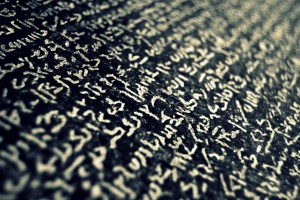
The e-Learning Ecologies MOOC: Week 4 Question
Make a post introducing a multimodal meaning concept. Define the concept and provide at least 1 example of the concept in practice. Be sure to add links or other references and images or other media to illustrate your point. If possible, select a concept that nobody has addressed yet so we get a well-balanced view of multimodal meaning. Multimodal meaning concepts might include:
Multiliteracies; Literacies (in the plural); New media; Digital media; Multimodal knowledge representations; Visual learning; Video learning; Simulations; Learning games; or suggest a concept in need of definition!
My Response
We are now into week 4, half-way through the e-Learning Ecologies MOOC, and the third of the seven “e-affordances” has been introduced: multimodal meaning – which draws upon a variety of literacies, such as multiliteracy, visual literacy, information literacy and such like. This short post will address the concept of digital literacy.
Once you start to scratch the surface of digital literacy, it soon becomes clear that it is an highly contested term, in what Baume (2012a, 2012b) describes as an “empty shell definition” because it places the development of “the definition on to the particular users, and thus increase local ownership” (ibid., 2012b), so that definitional variants spring up all over the place to suit a particular population or agenda.
One of my preferred definitions for digital literacy comes from the work by Martin & Grudziecki (2006) as part of their Pan-European DigEuLit Project (Martin, 2005), who propose that:
… digital literacy is the awareness, attitude and ability of individuals to appropriately use digital tools and facilities to identify, access, manage, integrate, evaluate, analyse and synthesise digital resources, construct new knowledge, create media expressions, and communicate with others, in the context of specific life situations, in order to enable constructive social action, and to reflect upon this process. (Martin & Grudziecki (2006)
The reason I particularly like this definition is that it expresses digital literacy as being constructed with some depth and breadth. There is some substance behind those words, it is not made up of bland, woolly platitudes – the definition firmly nails it colours to the mast, raising the term well beyond that of a set of competencies. Contrast it, then, with this recent re-interpretation of the term:
Digital literacies are those capabilities which fit an individual for living, learning and working in a digital society. (JISC, 2014)
I am, however, reminded by Weller (2011) who suggests that definitions “should probably be resisted, and [at] best interpreted as a shorthand term” (p.5). He goes on to argue:
As Wittgenstein argued with the definition of ‘game’ such tight definitions can end up excluding elements that should definitely be included or including ones that seem incongruous. (Weller, 2011:5).
As Buckingham (2008) carefully notes:
… a much broader reconceptualization of what we mean by literacy in a world that is increasingly dominated by electronic media. (ibid., 2008:88)
Thus, the Martin & Grudziecki (2006) definition soon loses its currency as the “improvements in technology mean that the goalposts are continually shifting and thus altering social practices” (Belshaw, 2011:179), and all that we are left with is the JISC (2014) definition of digital literacy that has been stripped to its bare essentials. Mindful of Weller’s (2011) warning and taking the essence of Martin & Grudziecki’s (2006) early definition, Belshaw (2011) has developed eight essential elements of digital literacies:
- Cultural
- Cognitive
- Constructive
- Communicative
- Confident
- Creative
- Critical
- Civic
Here, Belshaw presents to us a series of principles or precepts that are sustainable which provide the very building blocks of what it means to be digitally literate.
References
Baume, D. (2012a). “Digital Literacy and Fluency: SEDA initiatives supporting an enlightened approach to Academic Development in the field”. Educational Developments, 13(2), pp. 6-10. Available at: http://www.seda.ac.uk/resources/files/publications_129_Ed%20Devs%2013.2%20v3%20%28FINAL%29.pdf [Accessed 11.2.2015].
Baume, D. (2012b). “Digital literacies and digital fluency – a process of development?”. SEDA SIG blog, 14.11.2012. Available at: http://sedasig.wordpress.com/2012/11/14/digital-literacies-and-digital-fluency-a-process-of-development/ [Accessed 11.2.2015].
Belshaw, D.A.J. (2011). What is ‘digital literacy’? A Pragmatic investigation. EdD. Durham, England: Durham University. Available at: http://neverendingthesis.com/doug-belshaw-edd-thesis-final.pdf [Accessed 11.2.2015].
Buckingham, D. (2008). “Defining Digital Literacy: what do young people need to know about digital media?”. In: Lankshear, C. & Knobel, M. (Eds.), Digital Literacies: Concepts, Policies and Practices. New York, NY: Peter Lang Publishing Inc.
JISC. (2014). Developing digital literacies. JISC InfoKit. Bristol, England: Joint Information Systems Committee (JISC). Available at: http://www.jiscinfonet.ac.uk/infokits/digital-literacies/ [Accessed 11.2.2015].
Martin, A. (2005). “DigEuLit – a European Framework for Digital Literacy: A Progress Report”. Journal of eLiteracy, 2(2), pp. 130-136. Available at: http://www.jelit.org/65/ [Accessed 11.2.2015].
Martin, A. & Grudziecki, J. (2006). “DigEuLit: Concepts and Tools for Digital Literacy Development”. ITALICS, 5(4), pp. 249-267. Available at: http://www.ics.heacademy.ac.uk/italics/vol5iss4/martin-grudziecki.pdf [Accessed 11.2.2015].
Weller, M. (2011). The Digital Scholar: How technology is transforming scholarly practice. London, England: Bloomsbury Academic. Available at: http://nogoodreason.typepad.co.uk/files/thedigitalscholar.pdf [Accessed 11.2.2015].
